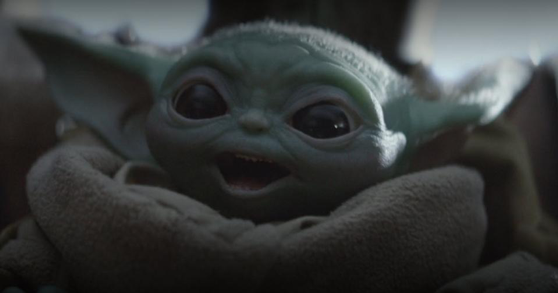Why Are We So In Love with Baby Yoda?
February 14, 2020
The internet exploded at the release of a new character referred to as “Baby Yoda” in Disney’s The Mandalorian. In this Star Wars television spin-off, a bounty hunter fights for the protection of a tiny, green baby who is put up for a large bounty due to his Jedi powers. But what is it about this little space alien that has everyone so obsessed? His much older counterpart, Yoda, did not make the internet blow-up with this loving reaction. Why does this small character gain such widespread love?
Believe it or not, that answer lies in the psychology and evolution of cuteness.
Why do we think things are “cute”?
Evolutionary psychology can explain why we as humans think some things are cute and others aren’t so much. Images of puppies, kittens, foals, joeys, pups, and other tiny animals seem to automatically elicit an “Awww, cute” reaction in all of us. What do all these animals have in common besides being so cute?
One thing is they are all offspring and need taking care of. According to evolutionary psychologists, “cute” is all about how we perceive babies or young ones. Whether we are parents or not, it is evolutionarily beneficial to take care of the next generation. Across many species, a parental instinct to care for the young kicks in automatically, resulting in parental behaviors that importantly contribute to an offspring’s survival. An offspring’s survival ups the chances that the family genes will continue to be passed along from generation to generation. From an evolutionary perspective, that’s the ultimate goal of a living organism: to not become extinct. So we have this “Awww” reaction to cute things when we want to nurture and take care of it.
But why did this biological recognition or reaction start happening to cute things? In other words, who decided what was “cute” and what was not?
One evolutionary hypothesis for this instinctual behavior is that our ancestors (way back when) started to favor “cuter” offspring (e.g., more symmetrical heads, smaller noses, bigger eyes). Perhaps it was because they were genetically fitter. It may also be explained by something more random, like a genetic mutation affecting a mom’s behavior to arbitrarily favor “big eyes” because she also had big eyes. Regardless, this care-for-the-cute bias most likely increased the offspring survival chance, resulting in the “cute” genes being passed on through generations. If that were true, it might mean babies just kept getting physically cuter and cuter.
What is “cute”, anyways?
Cuteness is a subjective idea usually based on the physical appearance of something or someone. Ethologist Konrad Lorenz first proposed the scientific concept of “cute” with his concept of a baby schema-- a set of facial and body features that make a creature appear “cute”. Features include things like a large head, round face, and big eyes. Babies have these defining characteristics, such as big round eyes, disproportionately large heads, big ears, small hands, chubby rolls, and short limbs. Konrad also thought these cute features had the evolutionary function of enhancing offspring survival--- so when something appears “cute”, it activates the parenting instinct or the strong urge to care for it in others.
So, anything with these baby traits pretty much causes us all to say “Awww”. The human mind is so susceptible to these characteristics, that it often takes just one of these traits--like big round eyes-- to make anything turn from average to adorable! The creators of the Baby Yoda character definitely knew some of this science when they added in these classic baby features to his design. Since this reaction appears to be subconscious, what is happening biologically behind the “Awww, cute” reaction?
What is going on in our brains when we see “cute”?
Other scientists have also noticed this strange “Awww” reaction that we have to things that are cute. In fact, scientist Melanie Glocker and her team wanted to know where this all takes place in the brain. These scientists showed research participants images of cute chubby tiny babies and studied their brain activity. The area responsible for pleasure, the Nucleus Accumbens, lit up like a light bulb! This pleasure center is responsible for the happy feeling we get after we see a cute image. This pleasure is caused by the release of a neurotransmitter called dopamine.
So, when we see Baby Yoda, our brains recognize the baby characteristics, release dopamine, and our nucleus accumbens fires up. It seems the Mandalorian must have a nucleus accumbens as well!
Over at Disney, they create some of the most adorable characters in pop culture. The way they design them is no mistake. We are convinced there is at least one evolutionary psychologist on the Disney design team. The big eyes, short limbs, and big heads are found in so many of their characters! Baby Yoda is no exception. So, the next time you watch The Mandalorian, remember that Disney is taking a card right out of evolutionary psychology’s playbook.




